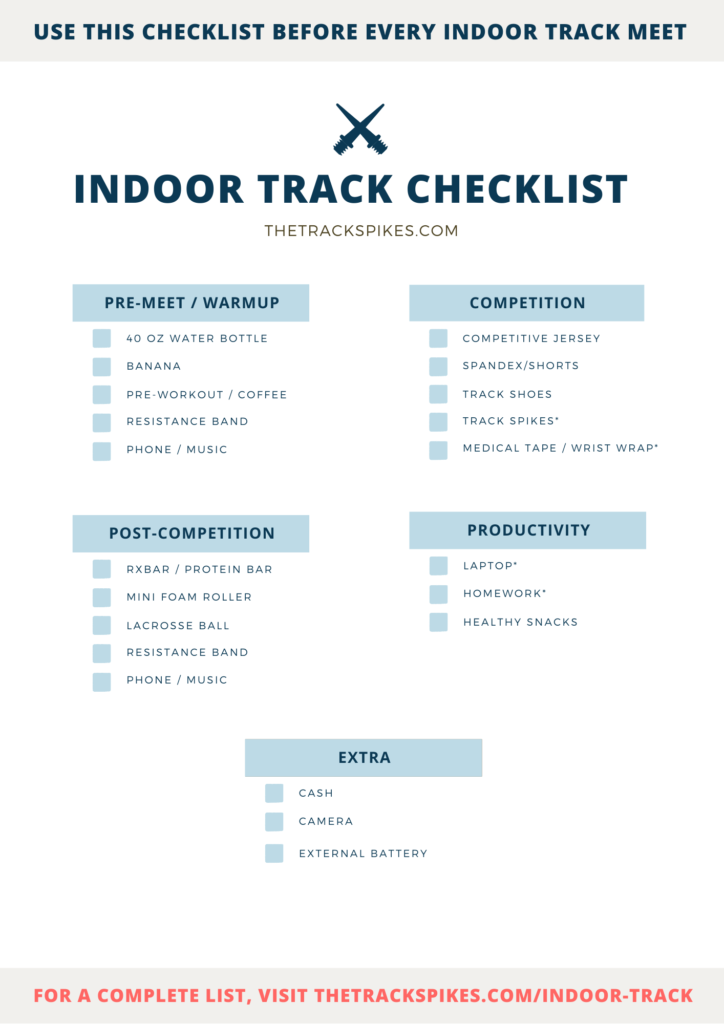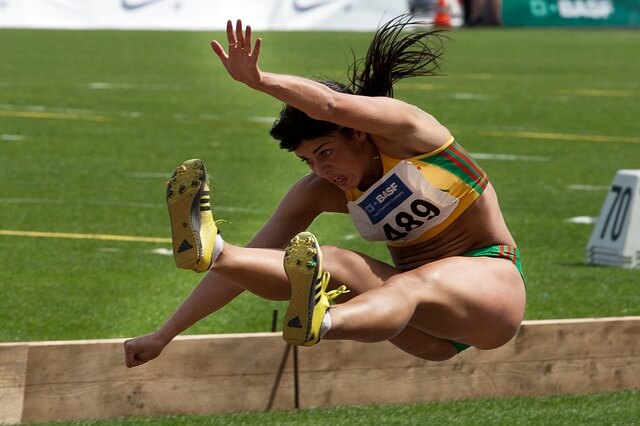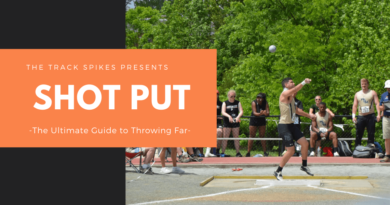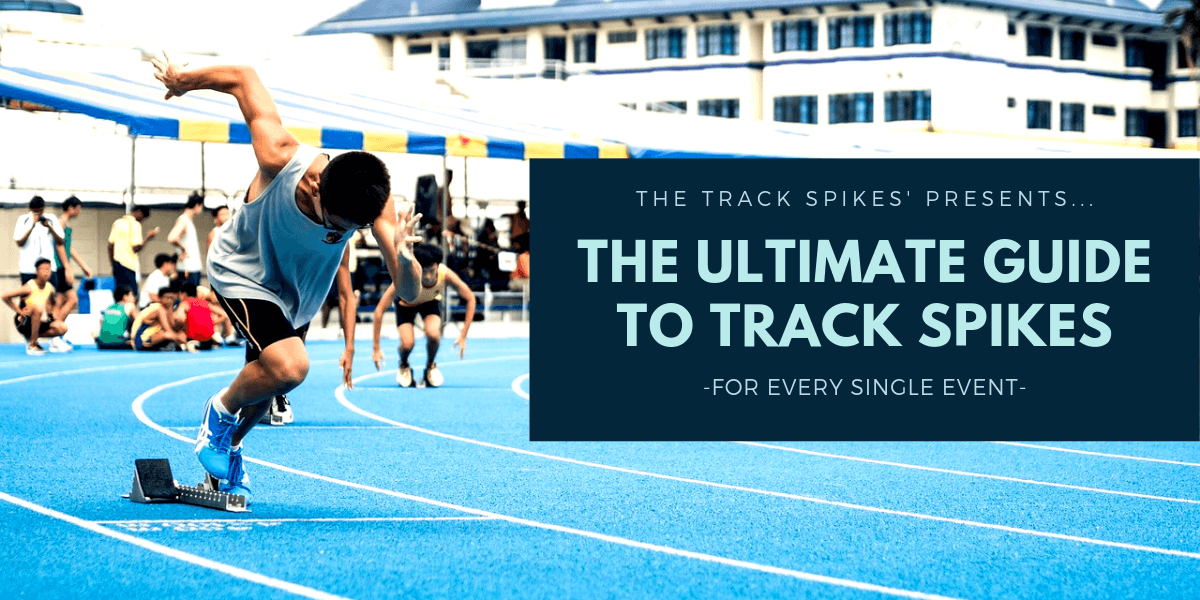15 Essentials to Pack for an Indoor Track & Field Meet

It doesn’t matter if you’re competing in high school or in college, indoor track meets are time-consuming. As a matter of fact, the average high school indoor track meet will last anywhere between 4-6 hours. If you’re not preparing accordingly, these meets can be grueling.
Luckily for you, we’ve created a must-have “Indoor Track Checklist” PDF for you to use. This PDF comes complete with everything that you’ll need before, during and after a competition.
In addition to this PDF, we’ll explain the importance of each item in this post. Honestly, I wish someone had given this to me in high school. Knowing all of this would have completely changed the game. I hope that by giving to you, that it will elevate game. In a highly competitive sport like track & field, every advantage you can have over your competitor counts.
What to Pack for an Indoor Track Meet: Pre-Competition
Every competition performance begins with a mindset. It starts the moment you hop on the bus to the indoor track facility. It starts the moment you enter the indoor track facility. Lastly, it starts when the moment you begin your warm-ups.
1. 40 fl oz. Reusable Water Bottle

Dehydration exposes you to a lot of problems. Mainly, studies have shown that it could lead to “a sudden decline in strength & coordination”. In the middle of my sophomore year indoor track season, I sustained a grade two calf strain that my athletic trainer said was “the worst grade two calf strain [they’ve] ever seen”. There were many reasons why the injury happened, but one of the factors was that I had not properly hydrated. From then on, I would try to drink at least 1-2 of these before a competition.
We’d recommend the Takeya Originals Vacuum-Insulated Stainless-Steel 40 oz Water Bottle. It’ll keep all of your beverages cold or hot for up to 24 hours. It’s leakproof, and easy to carry around especially as you being your warmup.
2. Bananas

Bananas were a staple when I competed. I would usually have 1-2 bananas about an hour before a competition. An NYT article called “Bananas vs. Sports Drinks? Bananas Win in Study” opened my eyes to the importance of carbohydrates pre-competition. The banana provides stronger anti-inflammatory benefits and allows for better recovery post-competition.
3. Pre-Workout

As a preference, you should only use pre-workout if you have consulted a healthcare professional first. Pre-workout effects different people in different ways. During the winter track season, you should try to marginalize caffeine intake as much as you can. That way, when you truly need caffeine prior to a meet, it can have its full effect at a lower dosage.
After consulting your doctor, we would recommend taking C4 Original Pre-Workout about 20 minutes before a competition. In the offseason, you should play with dosage and see how you perform optimally.
4. Resistance Band – Fit Simply Exercise Bands

We’d recommend bringing a small blue/black resistance band for your warmup. This is a great way to warm up your lower body, and can specifically help runners begin to slowly engage their quads and hamstrings. I’d always take a black resistance band and run through a custom-made warmup routine with them.
Additionally, resistance bands can also help out with your post-competition routine. I’ve seen numerous athletes use this to help with static stretching. Regardless of the outcome of the meet, you should always have some sort of cool-down or post-competition stretching routine.
5. LETSCOM Bluetooth Wireless Headphones

When I used to compete at a Division 1 level, I would always ensure to charge my wireless headphones the day prior to leaving for the meet. I would listen with LETSCOM Bluetooth wireless headphones. These wireless headphones gave me the flexibility to move around and not worry about a cable getting in the way of my warm-up. That way, I could listen to music on the way to get myself in the right mindset.
As a matter of fact, studies have proven that music helps bring focus to a competitor. An article titled the “Effect of Synchronous Music on Performance” details that humans match the tempo of the song.
What to Pack for an Indoor Track Meet: During Competition
6. Competitive Jersey / Bottoms

According to USATF rules and regulations, you cannot compete without a competitive jersey. If the meet requires a bib, we’d recommend immediately clipping it on to the front or back of your jersey. The official will usually tell you the appropriate location. When I competed, I would always go to a competitive meet wearing the jersey underneath all of my clothes. Additionally, I would leave an extra pair in another bag.
The only exception to this is if you’re competing unattached or as a redshirt. At that point, you are responsible for all competition fees and don’t represent an actual team. Proper track & field etiquette would be to use a regular single-color tee when competing. Usually, meets will require team issued shorts or bottoms. Some athletes prefer to have Under Armor compressions for a more comfortable fit. But, shorts always work as well. If you’re competing in a relay, all of your teammates must have the same outfit on as well.
7. Track Spikes
You need competitive track spikes to compete, or else you’ll end up running in sneakers, flats, or worse, borrowing your friend’s. Although I competed in the throwing events, I would also always keep my shoes in my backpack. That way, if I need to ensure that they were there, I could just reach back and feel them in my backpack. Don’t be a scrub. Get yourself a pair of track spikes so you increase your chances of getting a new personal record.

I would also argue that track and field athletes should have multiple track spikes on them. I would usually bring two throwing shoes: one for fast circles, and one for slow circles. It all depended on how the circle felt and which one I felt more comfortable in. I’m not exactly sure how applicable this would be to runners, but it worked for me. The important thing is to just not overthink this part.
Make sure to check out the facility rules before going to your competition. Ultimately, the majority of indoor track facilities permit 1/4 pyramid inch spikes (but no needle spikes).
If you’d like to check out our guide to track spikes, visit our “The Ultimate Guide to Track Spikes for Every Single Event“. To include cross country runners, we have created a buying guide for cross country spikes as well.
8. Medical Tape

Every athlete should pack themselves at least one roll of medical tape. While the majority of teams have a certified trainer on staff, it’s important that you get yourself medical tape in case if they’re busy. Every shot putter should have either medical tape or a wrist wrap to protect their wrist. If you’re a shot putter, Jordan Young did a fantastic video on how to tape your wrist for shot put or lifting:
What to Pack for an Indoor Track Meet: Post-Competition
9. CLIF Protein Bars

After your competition, you will want to refuel properly. CLIF BAR protein bars are some of the healthiest on the market. It’s imperative to have this within thirty minutes after the competition. I’d always pack maybe 2-3 CLIF bars in case if I ever got hungry. Regardless of the brand, you should definitely still pack yourself a snack with high protein.
10. TriggerPoint GRID Foam Roller

The biggest difference between elite level and novice level track & field athlete is that the elite level ones are disciplined. They follow a consistent routine for warm-ups and cool-downs and stick to it. Foam rolling after a competition is a must for all track & field athletes. This is exactly why we recommend the TriggerPoint GRID Foam Roller. I used to bring this with me to every meet and keep it at the top of my bag.
You should create a foam rolling/stretching plan with either your coach or your athletic trainer. Stay disciplined and focus on sustaining quality mobility. Having a TriggerPoint GRID Foam Roller is a great way to hit all of your muscles and allows for a more generic mobility exercise for your upper/lower body.
If you’d like to hit a more specific area to get rid of knots, a lacrosse ball should do the trick.
11. Lacrosse Ball

A simple lacrosse ball can help you get any nasty muscle knots before or after your competition. It can help target areas that need to be broken down more than a mini foam roller.
One thing that I did to save money was tape two tennis balls together. I would then use this to target specific muscles. I used the below video to help me make this tool.
12. Laptop / Homework
Since meets can historically last anywhere between 4-6 hours, it’s important to bring work with you. When I used to pack for indoor track meets, I always wanted to pack light. Therefore, if you have a textbook you need to bring, I would take a quick picture of the pages I had to read to lighten my load. Please, don’t be that guy that brings 3 textbooks to a meet only to read through 5 pages. If you are bringing value electronics to an indoor track meet, you should always have sight of your bag or ask someone to look after it if you leave.
13. External Charger – Anker Power Core 10000

At every indoor track meet, you see the same thing over and over again. At least two-three people crowded around each outlet to charge their phone & electronics. Again, please don’t be that person.
Instead, bring an Anker Power Core 10000 with you. Ensure that it has a full charge the night before and you’ll be set. The important thing to remember is that you need your music leading up to the competition. So don’t drain all your battery before the competition because you don’t want to either have to carry around an external battery during your warmups or not have any music at all.
14. Cash
Let’s be honest: every track & field meet has a concession stand that either is too expensive or unhealthy and not performance-enhancing. You always going to need cash (colleges usually give our per diem) to purchase food.
I would highly suggest going to a nearby location (if possible). Places outside the venue like a convenience store are likely to have the products you’re looking for at half the price. Make sure it is somewhere near the indoor track facility and that you check with your coach first.
15. Camera (for recruiting purposes)
If you’re trying to be recruited to an NCAA program (regardless of what Division), you need to document your practices, workouts, and competitions. When I was in high school, my coach would record all of our competitive throws on an iPad. That way, if a coach reached out, they could see exactly what my form looked like on my personal records. Coaches just like seeing updates in general. Even if you’re at practice, you should be filming your runs, jumps, and throws.
Before competing, always ensure that someone you trust is recording a video. Even if they don’t get your personal record on video, it’s okay. As long as it was an officially recorded meet, coaches will be able to see it on MileSplit.
Conclusion
In conclusion, there are a lot of essential things that you must bring to an indoor track & field meet. I wish someone had told me all of this in high school. Having all of these resources will allow you to perform at your peak every meet. Once again, if you haven’t printed out our PDF yet, give it a shot. If you have any further suggestions, please feel free to reach me at [email protected].



